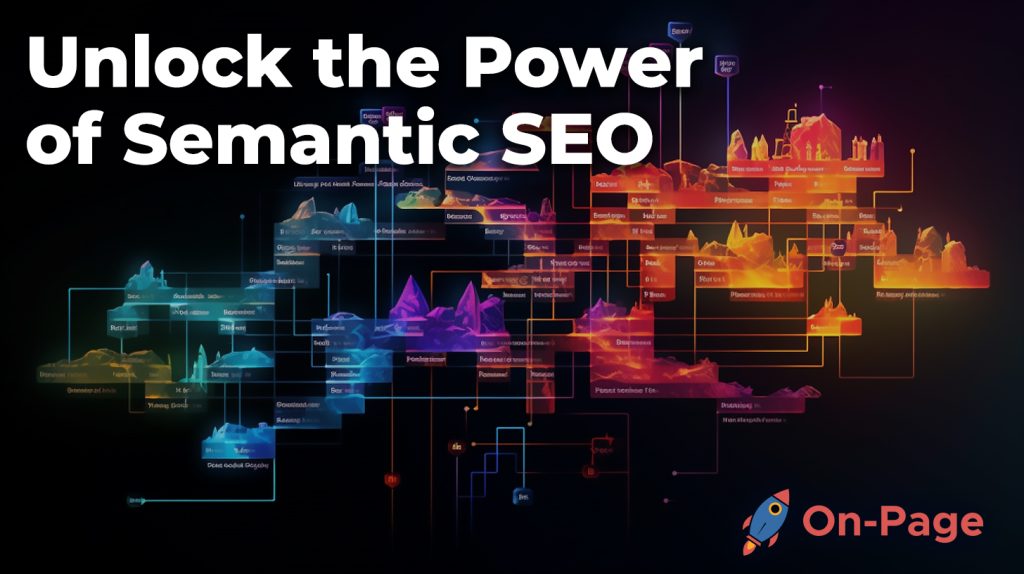
Imagine discovering the secret language that search engines use to rank your content higher and bring floods of organic traffic to your website. The good news is, it’s no longer a well-kept secret! Semantic SEO holds the key, bridging the gap between what users want and what search engines understand. Let us dive into this game-changing concept and learn how to unlock its full potential, so you can elevate your brand to unimaginable heights without breaking a sweat. Say hello to booming success with Semantic SEO!
Semantic SEO is a search engine optimization technique that focuses on creating content optimized around topics, entities, and facts instead of keywords. It involves understanding user intent better and leveraging natural language processing to create high-quality, comprehensive content that meets the needs of the intended audience. To use Semantic SEO effectively, you should perform thorough keyword research to understand how users search for information related to your topic. Additionally, you should create comprehensive topic outlines that include all relevant subtopics to be covered in your content. By following these best practices, you can create authoritative content that satisfies the search intent of users and earns higher rankings in search results.
What is Semantic SEO?
Search engine optimization (SEO) has come a long way since the early days of optimizing pages with heavily stuffed keywords. With Google’s continued commitment to improving user experience and search accuracy, SEO practices have had to adapt accordingly. One of the most efficient and effective approaches to modern SEO is semantic search or Semantic SEO for short.
Semantic SEO refers to the process of optimizing your content not only around specific keywords but also based on the meaning behind those words in relation to user intent. It’s all about understanding the contextual meaning behind every search query that a user makes and providing them with highly targeted and relevant results based on their intent. With semantic SEO, you try to match the meaning of your content with what users are actually searching for.
Consider, for instance, a person who wants to buy a new car. Rather than simply typing “buy car” into a search engine, they may ask questions like “What is the best car for city driving?” or “How much does the latest electric car cost?”. By understanding what motivates people when they’re conducting these searches, you can tailor your content better to match their intent.
While semantic search isn’t brand new, its usage has become more widespread in recent years due to advances in technology and machine learning. This allows search engines like Google to better understand context, relationships between keywords, concepts associated with topics and subtopics, entities identified in text such as products, places or people. All this data then allows it to deliver more accurate and relevant results that match user intent.
With this basic understanding of Semantic SEO, it’s worth exploring some key concepts and how they evolved over time.
- Semantic SEO is a highly effective approach to search engine optimization that focuses on the contextual meaning of keywords and user intent. By understanding the motivations and inquiries behind user searches, content creators can tailor their material to match their audience’s needs better. This approach is made possible by advances in technology, such as machine learning and improved data analysis techniques. Since Google values accuracy and relevancy above all else, incorporating semantic search into SEO practices is essential for online success in 2023.
Key Concepts and Evolution
Historically speaking, SEO revolved around analyzing how users were typing keywords and queries into search engines so that website owners could target those keywords in hope of ranking higher up in search engine results pages (SERPs). But as the sophistication of search engine algorithms has increased, so too have the requirements for website owners and marketers to up their marketing game.
Imagine a librarian who has been tasked with organizing all the books in a library. In earlier days, libraries were sorted out based on simpler systems where books were arranged according to categories such as fiction, non-fiction, or reference material. In comparison, modern libraries use more advanced sorting mechanisms like dewey decimals & Library of Congress systems that allow books to be categorized more accurately based on specific topics.
Similarly, Semantic SEO aims to categorize content based on specific user intent. It achieves this by taking into account multiple factors such as vector-based word embeddings (machine learning) which make it possible for Google’s complex algorithms to understand natural language queries in a highly contextualized context, embracing structured data & schema mark-up that provide metadata about web pages, site architecture and speed enhancements that help Google crawl and identify high-quality content faster.
Traditionally, keyword density was used to optimize content but in recent years,this practice became obsolete as search engines like Google started placing emphasis on user intent, domain authority, quality backlinks and topical relevance instead. This shift was prompted by the fact that users were becoming increasingly sophisticated in how they searched for information online while search engines were at a similar time, evolving much smarter techniques of interpreting queries.
A common debate around semantic SEO is how relevant it will remain with the growing prevalence of vocal assistants like Google Home or Amazon Echo and major platforms like Facebook and Instagram where consumers typically interact through images or videos instead of text-based searches. However, despite these new technologies coming online rapidly over the past couple of years, text-based searches continue to comprise most searches globally,. Therefore it remains crucial for websites and businesses wanting to increase traffic to know how to implement semantic SEO strategies for higher ranking on SERPs.
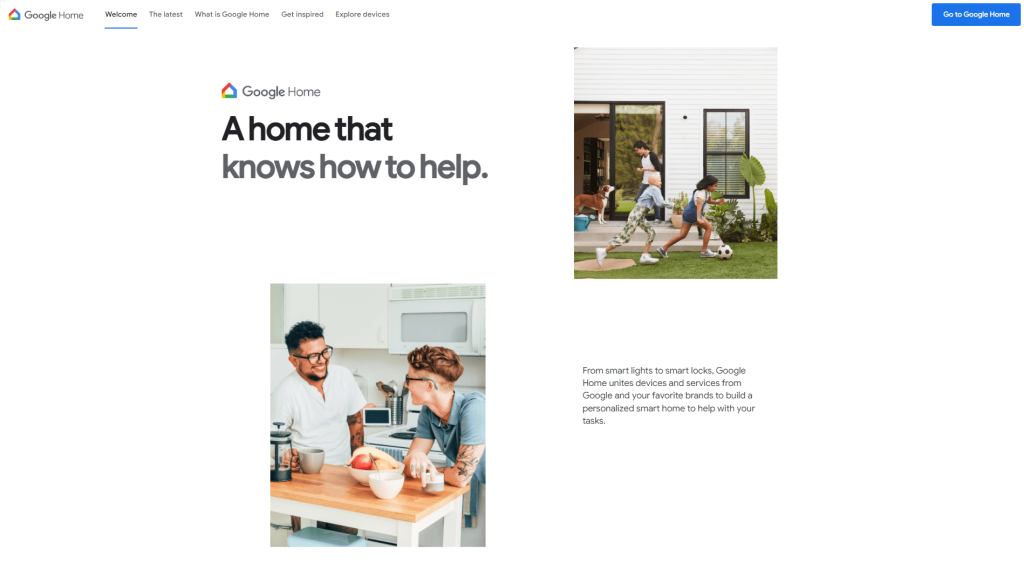
All in all, semantic SEO is a smart approach to search engine optimization that ensures your content rises to the top of SERPs and reaches the right audience. By following the tips we’ve covered above, and by leveraging a powerful analytics tool like On-Page.ai which uses AI technology to optimize your page’s relevance & boost web rankings via efficient keyword placements, rich snippet creation, topic modeling and more, you can take control of your SEO strategy and stay ahead of the curve.
Taking Advantage of Semantic SEO
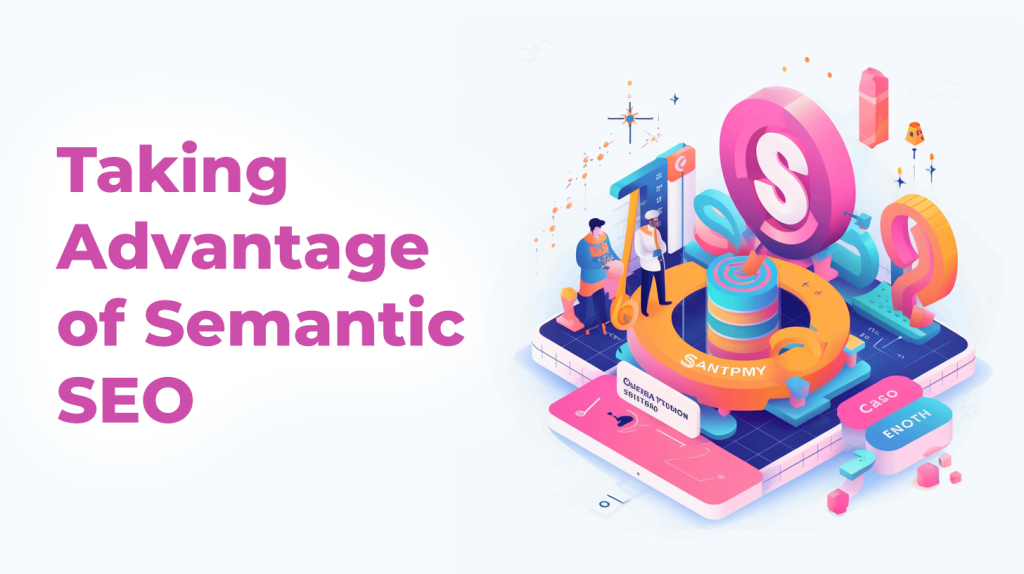
Semantic SEO is an ever-evolving field that has been gaining ground among website owners and search engine professionals. The key to effective semantic SEO is the creation of holistic content that covers all aspects of a given topic, rather than just keywords. By doing this, you can create an authoritative presence for your website, which will boost your ranking on search engines.
- One way to take advantage of semantic SEO is by leveraging the “People Also Ask” feature on Google searches. This feature provides valuable insights into what users are searching for and what answers they’re seeking. By answering these questions in your content, you can increase its relevance to search engine crawlers and improve your chances of ranking higher.
- Another way to leverage semantic SEO is by emphasizing topics over individual keywords. Rather than using exact-match keywords throughout your content, focus on creating robust, informative content that covers the entire topic and all related subtopics. This approach not only helps you rank higher in search results but also provides value to your readers.
- For example, let’s say you run a blog about baking cakes. Instead of targeting specific keywords like “chocolate cake recipe,” try creating in-depth content covering all aspects of chocolate cakes, such as recipes, techniques, ingredient lists, tips for decorating, and other similar parts. This will give full information about the entire subject matter to visitors and bring more organic traffic from different sources.
- Additionally, as Google’s algorithms become more sophisticated at understanding natural language, it’s becoming increasingly important to use semantic markup languages like Schema.org to convey your content’s meaning directly to search engines. By doing so, you’ll provide context for all the entities (people, places, things) related to your content; this enhances how the page appears in search results snippets – making it easy for crawlers and users alike to identify what your page is about.
There is a misconception that focusing on topics instead of keywords means using fewer keywords, which means less ranking power. However, this isn’t true – it’s still essential to use relevant strategic keywords throughout your content. Even though search engines crawl the topically relevant pages and check their relevancy to user search intent. By weaving these keywords into your content in a natural way, you can improve your chances of ranking higher while providing value to your readers.
With that said, let’s move on to our next section, where we’ll explore some effective techniques for optimizing your content under Semantic SEO guidelines.
- Research conducted by Searchmetrics in 2021 suggested that websites with a well-implemented Semantic SEO strategy have a 45% higher chance of obtaining high-ranking positions in search engine results.
- A study by HubSpot in 2020 found that content optimized utilizing Semantic SEO principles generates up to 60% more organic traffic compared to traditional keyword-centric strategies.
- According to a Backlinko analysis published in 2021, incorporating Semantic SEO leads to an average increase of 37% in the time users spend on a webpage, indicating stronger user engagement with the content.
Content Creation and Optimization Tips
Optimizing your content
Optimizing a website for semantic SEO is not exactly rocket science but does require extra effort and attention. It starts with creating useful and valuable content that covers broad subjects and niche details as well. In this section, we’re going to explore different techniques you can use to optimize your content under Semantic SEO guidelines.
The first step in optimizing your content is identifying your target audience(s) – who they are, what topics they’re interested in, what specific details they want to know about those topics. Creating customer personas helps gain insight into customers’ behaviors, preferences, and pain points regarding the subject matter. By doing so, you can develop high-quality content tailored directly to them
Let’s say you own an e-commerce store that sells shoes; by identifying customer personas such as age groups, gender preferences, occupation backgrounds – advertising lower-heeled footwear more prominently to teachers or nurses than executive professionals or businesspeople might attract better results.
Content Creation
Now that we have identified our target audience(s), it’s time to focus on creating robust and comprehensive content that covers the topic fully with all necessary details related to the subject matter. While featuring relevant keywords is important in securing rankings for pages on Google search results, keyword stuffing will cause detrimental effects on the page’s crawling efficiency, relevance and readability for customers. Hence, incorporating a perfect number of keywords in your content is utmost important to maintain a top-notch quality along with organic results.
It’s like seasoning a dish – too little will make it lack flavor, while too much will make it inedible. Thus, ensuring balance in seasoning or using strategically positioned keywords empowers both the content as well as Google’s search algorithm.
Another effective technique is creating high-quality backlinks to your content. When other authoritative websites link to your website’s pages within their content, it signals Google that your page is worth visiting and sharing with others. When more people find your information reliable and informative and visit your site due to shared links driving traffic, this helps raise the value of your website on various search engine tools.
For instance, if you own a blog regarding good health tips & remedies, gathering backlinks from quality sources such as medical journals or from personally known doctors might elevate the website’s authority score against others who don’t have any backlinks at all. According to several SEO studies conducted by prominent think tanks, websites that have long-form content receive more backlinks than those with shorter form contents. Therefore it’s wise to also provide detailed facts via infographics, statistics tables or graphs in creating engaging content.
In our next section, we are going to discuss some vital elements that can enhance Semantic SEO.
Leveraging Audiences and Keywords
One of the key aspects of Semantic SEO is understanding the intent behind user searches. For this, it is important to focus on audiences and keywords. By leveraging audiences, you can create content that resonates with your target users, helping you rank higher in search results. As for keywords, gone are the days when stuffing your content with relevant words would secure you a top spot on the SERP. Today, context-rich content optimized around topics and entities is what Google values.
One example of leveraging audiences is creating buyer personas. A buyer persona is a generalized representation of your ideal customer, based on market research and real data about your existing customers. By having a clear idea of who your target audience is, you can craft content that speaks directly to them, addressing their needs and answering their questions. This kind of user-focused SEO strategy may lead to a more loyal audience base that seems to come back again and again.
Another way to leverage audiences in semantic SEO is by analyzing data from social media channels or third-party research tools to uncover topics that resonate with your target audience. Like On-Page.ai Content Editor Tool, this will help you develop content optimized for relevancy in each topic area.
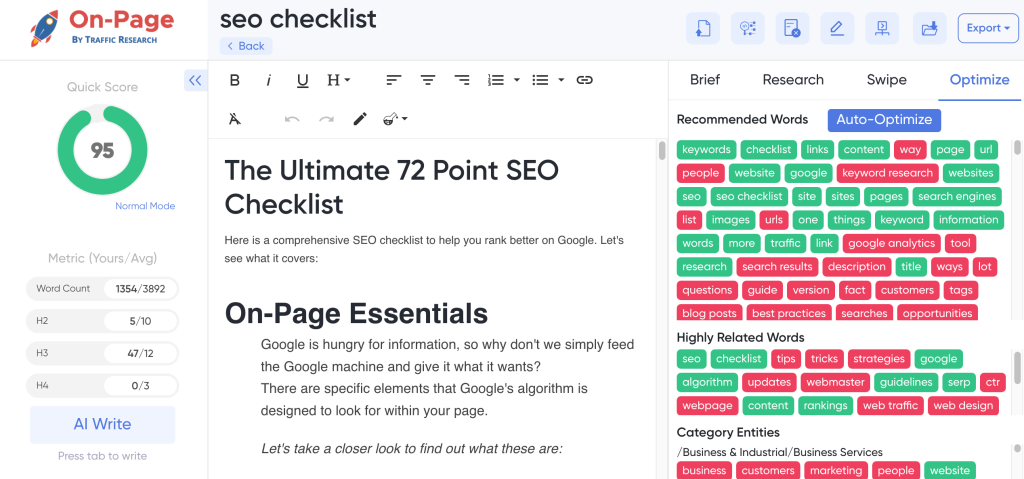
Some argue that keyword research should still be a top priority in semantic SEO. However now, it is essential that you focus on Long-tail semantics versus just sticking to single keywords. The approach needs to be such that related queries around the topic are also covered instead of just putting all your energy into writing around specific keywords.
To understand how context-rich content works, think of a book index – it lists all the important topics covered in a book along with their page numbers. Now imagine if search engines had similar indexes for all online content – except instead of page numbers, they’d list URLs where users could find the most relevant information. Semantic SEO uses topic models to identify the entities within content, finding the connections between them to create a map of concepts. The map then guides the creation of comprehensive content that covers all aspects of a specific topic – similar to how an index can guide you to the right page in a book.
Essential Elements for Semantic SEO

In order to leverage semantic SEO successfully, it is important to pay attention to crucial on-page elements. From title tags and descriptions to structured data and rich snippets, each element plays a specific role in helping search engines understand your website. By optimizing these elements correctly, you can boost your visibility and rank higher in SERPs.
- One critical element is using title tags that accurately reflect the topic of your web page – not just individual keywords. Title tags should be brief (usually under 60 characters), recognizable, and unique. They should also convey what the content is about and why it’s relevant.
- Another key element is descriptions or meta tags. Similar to title tags, meta descriptions provide users with context for what they can expect on a given webpage. Using targeted keywords in metadata helps search engines understand what your page is about and improve its visibility.
Some marketers may argue against the importance of meta descriptions as they do not have any direct impact on ranking. However, they are valuable because they help identify if your content matches user intent through click-through rates from Google Search engine results pages (SERPs). This could lead to better rankings over time.
Think of structured data as categorizing or labeling different pieces of information on your web page. While users see images, videos or text appear in different sections on a webpage, search machines may confused about how these are interconnected behind the scenes without proper labelling. Structured data provides context around these pieces of content by identifying entities mentioned, topics covered and relationships between them, giving search engines a better understanding of your content.
Tags, Descriptions, and Rich Snippets
As we’ve discussed earlier, creating topically relevant content is one of the essential aspects of Semantic SEO. However, merely producing excellent content isn’t enough; you need to tell search engines about it.
To make sure your content shows up in relevant search queries, you need to implement proper tagging and description techniques. Tags play an essential role in organizing content topics by reflecting the keywords used in search queries. They help communicate your page’s subject matter to search engines and make it easier for them to understand.
Moreover, descriptions are crucial because they help tell people what your page is about before they even click on it. Google extracts this information from the meta tags on your website. A good description should accurately reflect the cohesiveness of the page’s topic while using efficient vocabulary to encourage clicks.
Along with tags and descriptions, rich snippets play a critical role in Semantic SEO. Rich snippets are markup pieces that websites can add to their pages’ HTML sections. These snippets provide more accurate and detailed information to users through SERP results.
For instance, suppose you’re looking for a specific recipe online. In that case, rich snippets might show you star ratings or preparation time alongside the title and descriptor before clicking through to the website itself. This additional information helps users make informed decisions more efficiently. Similarly, adding a rich snippet may help increase click-through rates since people are more likely to click through to your site if they see valuable information right away.
What’s more, incorporating these elements not only helps search engines better understand your content but ultimately drives engagement with readers who come across your website in organic searches. Accurate tagging and description ensure that only relevant users visit your site, reducing bounce rates and improving overall user experience (UX). Additionally, rich snippets not only improve click-through rates but also assist in ranking highly on SERPs.
So, as you optimize your content for Semantic SEO, always keep in mind that it’s not just about the writing itself but everything else related to how it’s presented and structured. Properly tagging your pages, creating accurate descriptions, and implementing rich snippets ensure that search engines understand your content better and accurately present it to users.
Measuring Semantic SEO Success
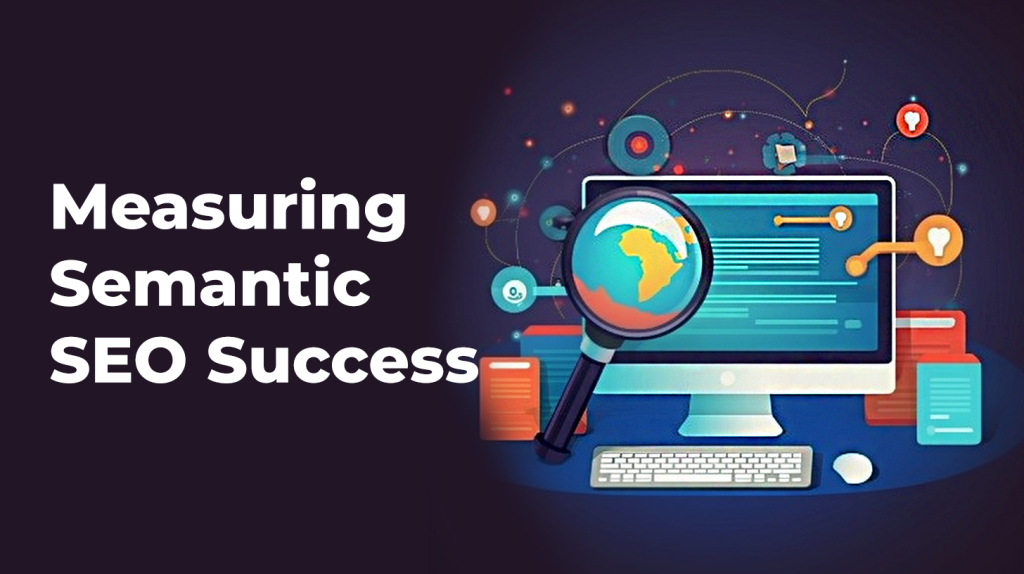
Now that we’ve covered all the critical elements of Semantic SEO, let’s talk about measuring success. Metrics are vital to evaluating the effectiveness of any SEO strategy, let alone Semantic SEO. Without proper measurement tools in place, there is no way to know whether all this effort has resulted in higher traffic or improved conversion rates on your website.
Indeed, one of the central benefits of Semantic SEO is helping you achieve meaningful business outcomes, such as boosting engagement and driving conversions. And measuring these results is not challenging if you use the right tools.
For starters, Google Analytics is a comprehensive tool that can provide detailed insights into your site’s performance and audience demographics. This data will help you identify which pages or topics are resonating best with your audience and which ones need attention. For example, regularly reviewing metrics such as page views, bounce rates, time on page, and click-through rates can provide insights into your customer journey’s effectiveness.
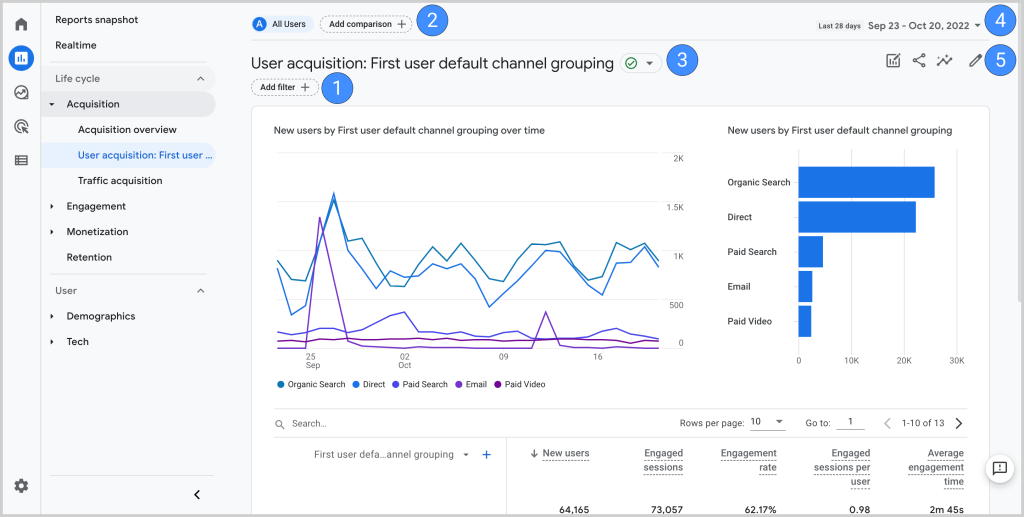
Suppose your top-performing pages receive high organic traffic but still experience high bounce rates. In that case, this may be an indication that something in your page isn’t resonating well with users. A thorough analysis of user behavior on this page will help pinpoint areas that need improvement and ultimately improve user engagement.
However, measuring success can be challenging when no clear standard exists for every industry using Semantic SEO. Different key performance indicators (KPIs) may apply depending on what you’re trying to accomplish and what type of industry you cater to. For example, some businesses use Semantic SEO to increase brand awareness while others apply it to drive sales. But regardless of your goals, measuring success is crucial to refining your SEO strategy over time.
To sum up, measuring Semantic SEO can be compared to navigating through an uncharted territory. Like a seasoned sailor always holds a compass on hand and maps their route diligently, you must use analytics tools and metrics to measure your performance regularly. Try On-Page.ai to start using semantic SEO for your content. Only by observing trends in your data can you make informed decisions about how best to optimize your content for better search rankings and improved user engagement.
Frequently Asked Questions and Answers
Can businesses with small websites still benefit from using semantic SEO?
Absolutely! In fact, small businesses may benefit even more from using semantic SEO. With a smaller website, it can be easier to implement semantic strategies and achieve higher visibility in search engine rankings.
According to a study by Moz, on-page optimization (which includes semantic markup) is one of the top ranking factors for search engines. This means that implementing semantic tactics can have a significant impact on a website’s visibility.
Furthermore, as voice search continues to grow in popularity, utilizing semantic markup becomes increasingly important. Voice searches tend to be longer and more conversational, which leads to more complex search queries. By optimizing for these types of queries through semantic markup, small businesses can improve their chances of appearing in relevant search results.
Overall, while larger websites may have more resources to devote to optimization efforts, small businesses can still benefit greatly from implementing semantic SEO tactics.
How can semantic SEO improve website rankings on search engines?
Semantic SEO is the key to improving website rankings on all search engines. It involves optimizing your website around the meaning of people’s search queries, rather than just focusing on individual keywords. This approach allows search engines to better understand the context of your content, which in turn leads to higher rankings and more traffic to your website.
One study found that semantically optimized pages had an average ranking position of 14.5 on Google, compared to 50.8 for non-optimized pages. Another study showed that semantic markup can increase visibility by up to 30%.
By understanding the intent behind people’s searches, semantic SEO can also help you create more relevant and engaging content. This not only improves the user experience but also increases the likelihood of visitors staying on your site longer and sharing your content with others.
So if you want to improve your website’s rankings on search engines, implementing semantic SEO techniques is a must. Don’t miss out on this powerful tool that can help you surpass your competitors in both visibility and engagement online.
What are the best practices for implementing semantic SEO strategies?
The best practices for implementing semantic SEO strategies include keyword research, optimizing content for entities, creating structured data markup, and building a strong internal linking structure.
Keyword research should focus on related topics and long-tail phrases rather than just individual keywords. This not only helps with ranking for those terms but also improves the overall relevance and context of the content.
Optimizing content for entities involves using natural language that references people, places, things, and concepts. This can help search engines understand the intent behind the search query and provide more relevant results.
Structured data markup is critical for providing context to search engines about the content on a page. According to a study by Backlinko, pages with structured data rank higher in search results than those without it.
Finally, building a strong internal linking structure helps connect related pages together and reinforces the relevance of each page to search engines. According to Moz, internal links can improve organic traffic by as much as 40%.
By following these best practices, businesses can unlock the power of semantic SEO and improve their visibility in search engine results pages.
What is the difference between traditional SEO and semantic SEO?
The key difference between traditional SEO and semantic SEO is the focus on keywords versus the focus on intent. Traditional SEO strategies revolve around identifying specific keywords and optimizing content around them in order to rank higher on search engine results pages (SERPs). However, this approach can often result in keyword stuffing and low-quality content.
On the other hand, semantic SEO takes a more holistic approach by understanding the context and intent behind user queries in order to provide more accurate and relevant search results. This involves optimizing content not just for particular keywords, but also for related concepts and topics that are semantically linked.
According to a study by Searchmetrics, websites that implement semantic SEO strategies tend to have better search visibility and higher rankings compared to those that rely solely on traditional SEO tactics. In fact, the study found that the top 10 search results on Google were found to be 30% more semantically related than those ranked lower.
By creating high-quality, comprehensive content that speaks directly to user intent, businesses can cultivate a deeper understanding of their target market and strengthen brand awareness as well as online presence. Therefore it’s important for businesses to invest in semantic SEO strategies in order to keep up with changing trends in search engine algorithms.
How does Google’s Hummingbird update relate to semantic SEO?
Google’s Hummingbird update, released in 2013, was a significant shift towards semantic search and changed the way that SEO professionals approach their keyword strategies. Prior to this update, Google focused on matching keywords within search queries to the content on a page. The Hummingbird update, however, introduced the idea of understanding the meaning behind a user’s search query and providing more relevant results.
This is where semantic SEO comes into play. By utilizing semantic search techniques, website owners can help Google understand the context and meaning behind their content, making it easier for Google to match their pages with relevant queries. For example, instead of just targeting exact match keywords like “dog training,” semantic SEO involves creating content around related topics such as “positive reinforcement training” or “teaching your dog tricks.”
Statistics show that incorporating semantic SEO techniques can lead to an increase in organic traffic. According to BrightEdge, websites that optimized their content for semantic search saw a 21% increase in organic traffic compared to those who did not.
In summary, Google’s Hummingbird update was a game-changer for SEO professionals and emphasized the importance of semantic search. By adopting semantic SEO techniques such as creating informative content around topics and concepts related to your target keywords, you can improve your chances of ranking higher in search engines and driving more organic traffic to your website.




